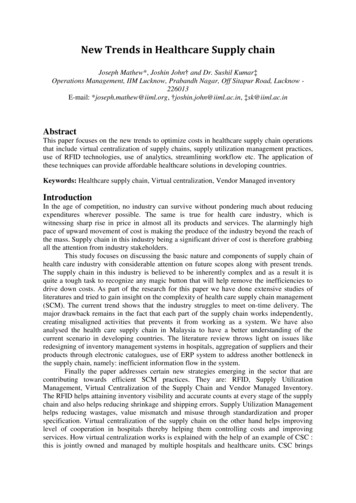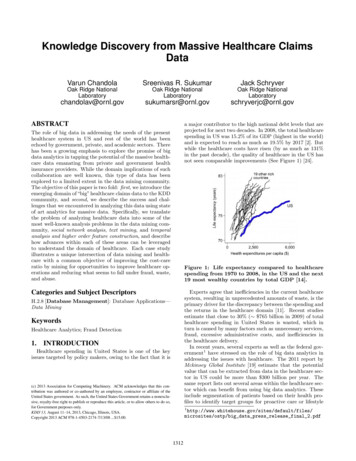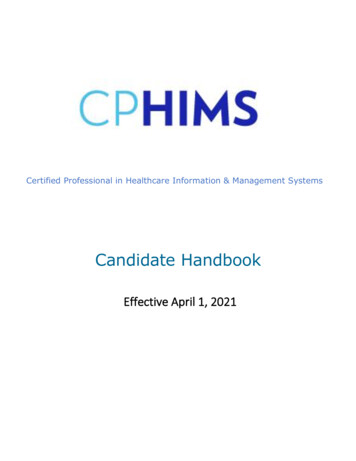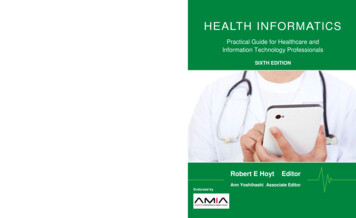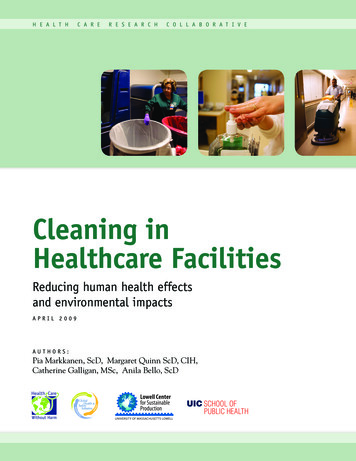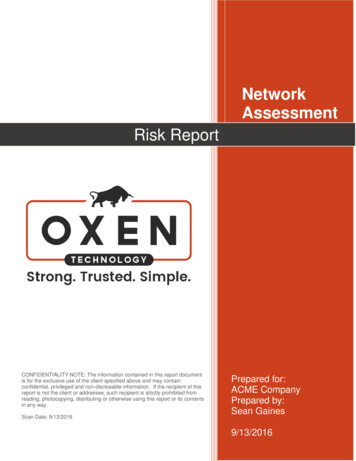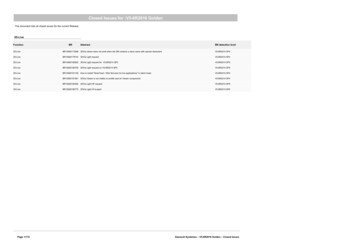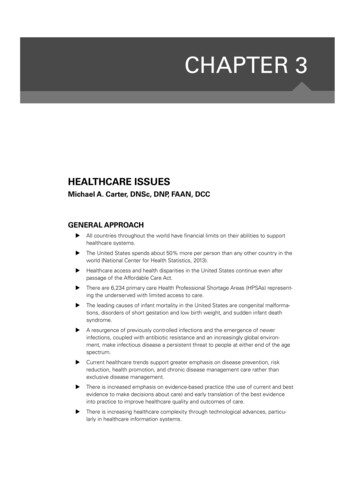
Transcription
CHAPTER 3HEALTHCARE ISSUESMichael A. Carter, DNSc, DNP, FAAN, DCCGENERAL APPROACHXAll countries throughout the world have financial limits on their abilities to supporthealthcare systems.XThe United States spends about 50% more per person than any other country in theworld (National Center for Health Statistics, 2013).XHealthcare access and health disparities in the United States continue even afterpassage of the Affordable Care Act.XThere are 6,234 primary care Health Professional Shortage Areas (HPSAs) representing the underserved with limited access to care.XThe leading causes of infant mortality in the United States are congenital malformations, disorders of short gestation and low birth weight, and sudden infant deathsyndrome.XA resurgence of previously controlled infections and the emergence of newerinfections, coupled with antibiotic resistance and an increasingly global environment, make infectious disease a persistent threat to people at either end of the agespectrum.XCurrent healthcare trends support greater emphasis on disease prevention, riskreduction, health promotion, and chronic disease management care rather thanexclusive disease management.XThere is increased emphasis on evidence-based practice (the use of current and bestevidence to make decisions about care) and early translation of the best evidenceinto practice to improve healthcare quality and outcomes of care.XThere is increasing healthcare complexity through technological advances, particularly in healthcare information systems.
52FAMILY NURSE PRACTITIONER REVIEW AND RESOURCE MANUALRED FLAGSXHealth disparities: the difference in the incidence, prevalence, mortality, and burdenof disease and other adverse conditions that exist among specific population groupsin the United States (National Institute on Aging, 2008)XAccess: the availability (or lack thereof) of healthcare services to allXMedically underserved community: a setting with a shortage of primary care, dental,and/or mental health servicesXVulnerability: open to physical, emotional, and/or socioeconomic harmXDisadvantaged: inhibited from knowledge, skills, and abilities to participate in thehealthcare system as a provider and/or a receipt of health care because of economic,social, ethnic, or racial background, and/or physical or mental impairmentXUnderrepresented minorities: racial and ethnic populations whose representationamong the health professions is lower than their proportion of the general populationXSocial determinants of health: defined by the World Health Organization as “conditions in which people are born, grow, live, work, and age, and the wider set of forcesand systems shaping the conditions of daily life” (WHO, 2015)THE PATIENT PROTECTION AND AFFORDABLE CARE ACTXPatient Protection and Affordable Care Act (ACA) became law in 2010 (U.S.Department of Health and Human Services, n.d.).XPersons are now required to have insurance under the ACA, but 11.4% of U.S. citizens are still without insurance in March 2015 (Obamacare Facts, 2015).XACA ended preexisting condition exclusions, keeps adults under 26 years old onparents’ plan, and ended lifetime limits.XACA requires insurers to offer preventive care with no copayment.NATIONAL HEALTH PREVENTION STRATEGYThe National Prevention Strategy (Centers for Disease Control & Prevention, n.d.) presentsevidence-based recommendations designed to reduce the burden of the most-common preventable causes of disease and death. The aim of this initiative is to guide the nation in the mosteffective and achievable ways to improve health and well-being. The strategic directions includehealthy and safe community environments, clinical and community preventive services, empowered people, and the elimination of health disparities. Here are the priority areas:XTobacco-free livingXPreventing drug abuse and excessive alcohol useXHealthy eatingXActive livingXInjury- and violence-free livingXReproductive and sexual healthXMental and emotional well-being
HEALTHCARE ISSUESMODEL EPIDEMIOLOGIC PRINCIPLESDefinitionXThe study of how disease is distributed in populationsXIncludes factors that influence this distribution (Gordis, 2014)Natural History of DiseaseThe course of disease is one of development, expression, and progression in a person over time.Several stages appear to be universally descriptive:XStage of susceptibility (pre-pathological)XStage of pre-symptomatic disease (subclinical)XStage of clinical diseaseXStage of disability (or death)Prevention of DiseaseThe goal is to intervene as early as possible to prevent disease or disability.Primary PreventionXInterventions at the stage of susceptibility, directed at preventing disease fromoccurringXEducation, exercise, nutrition, water fluoridation, immunizations, food-handling regulations, pollution controlSecondary PreventionXInterventions at the subclinical stage, directed at early detection of the illness orproblem to reduce the progress and severity of the diseaseXGenetic testing in newborns, lead screening, vision and hearing screening, smokingcessation programs, cholesterol screening, and mammographyTertiary PreventionXInterventions at the clinical stage of disease, directed at treatment and rehabilitationof the illness to prevent or minimize progression of the disease or its sequelae, suchas disabilityXUse of inhaled steroids in the management of asthma and penicillin prophylaxis inpatients with sickle cell anemiaEtiologyThe cause or the web of causation of a disease or problem:XAny factors (direct or indirect) that increase the likelihood of diseaseXPrevalence rates describe the number of persons who have a condition in the population at a specific time divided by the number of people in the population.XIncidence rates describe the number of new cases that occur during a specified timein a group at risk. See Table 3–1, which identifies the leading causes of death per agegroup.53
54FAMILY NURSE PRACTITIONER REVIEW AND RESOURCE MANUALTABLE 3–1.LEADING CAUSES OF DEATH BY AGE GROUPAGECAUSE OF DEATHUnder 1 yearCongenital anomaliesShort gestationMaternal complicationsSudden infant death syndrome (SIDS)Unintentional injuriesPlacenta, cord, or membranesBacterial sepsisRespiratory distressCirculatory system diseaseNeonatal hemorrhage1–4 yearsUnintentional injuriesCongenital anomaliesHomicideMalignant neoplasmHeart diseaseInfluenza and pneumoniaChronic lower respiratory diseaseSepticemiaBenign neoplasmPerinatal period5–9 yearsUnintentional injuriesMalignant neoplasmCongenital anomaliesHomicideChronic lower respiratory diseaseHeart diseaseInfluenza and pneumoniaCerebrovascular diseaseSepticemiaBenign neoplasm10–14 yearsUnintentional injuriesMalignant neoplasmSuicideCongenital anomaliesHomicideHeart diseaseChronic lower respiratory diseaseInfluenza and pneumoniaCerebrovascular diseaseBenign neoplasms
HEALTHCARE ISSUESAGECAUSE OF DEATH15–24 yearsUnintentional injuriesSuicideHomicideMalignant neoplasmHeart diseaseCongenital anomaliesInfluenza and pneumoniaDiabetes mellitusComplicated pregnancyChronic lower respiratory disease25–34 yearsUnintentional injuriesHomicideSuicideMalignant neoplasmHeart diseaseDiabetes mellitusLiver diseaseHIVCerebrovascular diseaseInfluenza and pneumonia35–44 yearsUnintentional injuriesMalignant neoplasmHeart diseaseSuicideHomicideLiver diseaseDiabetes mellitusCerebrovascular diseaseHIVInfluenza and pneumonia45–54 yearsMalignant neoplasmsHeart diseaseUnintentional injuriesLiver diseaseSuicideDiabetes mellitusCerebrovascular diseaseChronic lower respiratory diseaseSepticemiaHIV(CONTINUED)55
56FAMILY NURSE PRACTITIONER REVIEW AND RESOURCE MANUALAGECAUSE OF DEATH55–64 yearsMalignant neoplasmsHeart diseaseUnintentional injuriesChronic lower respiratory diseaseDiabetes mellitusLiver diseaseCerebrovascular diseaseSuicideSepticemiaNephritis65 years and olderHeart diseaseMalignant neoplasmChronic lower respiratory diseaseCerebrovascular diseaseAlzheimer’s diseaseDiabetes mellitusInfluenza and pneumoniaUnintentional injuriesNephritisSepticemiaAdapted from “10 Leading Causes of Death by Age Group, United States – 2013,” by Centersfor Disease Control and Prevention, 2013. Retrieved from http://www.cdc.gov/injury/wisqars/pdf/leading causes of death by age group 2013-a.pdfRisk FactorsXAge, sex, social, cultural, familial, racial/ethnic, genetic, occupation, and lifestylehistory represent potential sources of problems and diseases that may be difficult orimpossible to alter.XRisk reduction programs may be established to decrease the vulnerability of personsto certain problems by modifying some risks.Communicable or Infectious DiseasesIllnesses caused by organisms that attack and invade vulnerable personsXInvolve identification of causative agents,XRely on microbiology principles in understanding life cycle of organism,XFocus on intervention at vulnerable phases in course of disease or life cycle of organism, andXUse selected infectious disease definitions (Box 3–1).Reservoirs of InfectionXCases and carriersXAnimal carriers (lower vertebrate animals)
HEALTHCARE ISSUESBOX 3.1INFECTIOUS DISEASE DEFINITIONSGeneral Definitions Infection: colonization and multiplication of an organism in the host, typically producingan immune response but no signs or symptoms Disease: Stage when an infection produces signs and/or symptoms (including pathologic changes). Certain organisms (such as influenza virus) are capable of infection withor without producing disease; other organisms (such as measles virus) always producedisease in susceptible persons. Disease may vary in severity. Colonization: The organism invades the host at a particular site, multiplies, and acts as aparasite but does not produce infection, immune response, or disease. Carrier state: persistence of an organism in a host; this stage may follow infection, disease, or colonization and may be infective to othersAgent (Organism) Properties Infectivity: Ability of an organism to invade and multiply in a susceptible host. Varicella ishighly infective, rhinovirus is intermediate, and tubercle bacilli are of low infectivity. Pathogenicity: Ability of an organism to produce disease. Rabies, rhinovirus, and varicellaare highly pathogenic; adenovirus and rubella are intermediate; and tubercle bacillus islow. Virulence: Severity of disease that an organism can produce, measured by criteria suchas number of days in bed or the frequency of serious sequelae including death (fatalityrate). Rabies virus is highly virulent (nearly 100% fatality rate); poliovirus is moderatelyvirulent; varicella and rhinovirus are of low virulence (almost zero fatality rate). Immunogenicity: Ability to produce a lasting and effective immunity. Rhinovirus, whichprimarily acts locally, results in a poor systemic immune response. Systemic viral infections such as measles produce lasting immunity.Agent–Host Relations Latent infection: The organism is not shedding or obtainable (likely hidden in host cells).Patent infection: The organism is shedding and/or obtainable from such areas as feces,urine, blood, or respiratory tract. Certain infections may remain permanently patent(some cases of hepatitis B) or be intermittently patent (herpes virus), or, after beinglatent for a long time, reactivate and produce disease (tuberculosis and herpes zoster).Period of communicability: the time when sufficient numbers of organisms are shed tocause transmission; usually concurrent with disease but not alwaysIncubation period: the time from exposure to the onset of disease XInvertebrate hosts (insects)XInanimate objects: Some infectious agents are free-living in the environment, multiplying on inanimate objects (such as Salmonella in food, Legionella in pools of water,and Histoplasma in oil).Mechanisms of Transmission of InfectionXDirect: through touching, kissing, sexual intercourse, childbearing, breastfeeding,transfusionsXIndirect: through air, vector (insects, animals), vehicle (food, water, towels)57
58FAMILY NURSE PRACTITIONER REVIEW AND RESOURCE MANUALControl MeasuresXMeasures directed against the reservoir: isolation, quarantine, insect sprayingXMeasures that interrupt the transmission of organisms: water purification, milk pasteurization, barrier protection during sexual intercourseXMeasures that reduce host susceptibility: immunization, appropriate use of antibiotics, improved nutritionConcepts of Epidemic vs. Endemic InfectionsXGeneration time: interval between receipt of infection and the maximal communicability of the host; applied to both subclinical and clinical infections (incubation periodapplies only to clinical cases); used to describe and analyze the spread of infectiousdiseases (i.e., common vehicle, single-exposure epidemic, determined by the incubation or generation time)XHerd immunity: resistance of a group to invasion and spread of an infectious agentbecause a large portion of the group is immune; decreases the likelihood of an epidemic in an areaXEndemic: a disease or infectious agent that is usually present in a populationXEpidemic: occurrence of disease in excess of what is normally expected in apopulationXMorbidity: occurrence of illness in a populationXMortality: occurrence of death in a populationHUMAN DEVELOPMENTDefinitionXMost development is patterned and orderly, with both a purpose and a direction.XDevelopment is continuous throughout life, although the degree of change in manyareas decreases after adolescence.XDevelopment may occur simultaneously in several areas, such as physical and social,but the rate of change in each area varies.XThe pace of development varies among persons.XPhysical and mental stress during periods of critical developmental change, such aspuberty, may make a person particularly susceptible to outside stressors.XAnticipatory guidance is an important component of patient and family educationthroughout the life span.Infant and Child DevelopmentXAssessment of growth is determined by routine monitoring of height, weight, headcircumference (until age 2), dental development, and appearance of secondary sexcharacteristics.XAdequacy of growth is determined by comparison with normal growth parameters(see Tables 3–2 through 3–5) and/or plotting the measurements of height, weight,
HEALTHCARE ISSUESTABLE 3–2.NORMAL GROWTH PARAMETERS FOR HEIGHT AND WEIGHTAGEWEIGHT*HEIGHT*Newborn95% of newborns weigh 5–10 lbsApproximately 5%–10% of bodyweight is lost in first few days,then birth weight is regained in7–10 days.95% of newborns are between 18 and22 in. long.Birth–6monthsWeekly gain 140–200 g(5–7 ounces). Birth weight doublesby 6 months.Monthly gain is 2.5 cm (1 in.).6–12 monthsWeekly gain 85–140 g (3–5 ounces).Birth weight triples by age 1 year.Monthly gain is 1.25 cm (0.5 in.). Birthlength increases by approximately50% by age 1 year.ToddlersYearly gain 2–3 kg (4½–6½ lbs).Growth is approximately 12 cm (5 in.)between ages 1 and 2 years; 6–8cm (2½–3½ in.) between ages 2 and3 years. Approximately 50% of adultheight is reached by age 2 years.School ageYearly gain approximately 2–3 kg(4½–6½ lbs ).Growth is approximately 5–6 cm(2–2½ in.) per year. Birth lengthdoubles by age 4 years and triples byage 13 years.Puberty—girls(10–14 years)Weight gain 15–55 lbs (mean38 lbs).Growth is approximately 5–25 cm(2–10 in.). 95% of adult height isachieved by menarche (skeletal ageof 13 years).Puberty—boys(11–16 years)Weight gain 15–65 lbs (mean52 lbs).Growth is approximately 10–30 cm(4–12 in.). 95% of adult height isachieved by skeletal age of 15 years.*These measurements are averages.Adapted from “CDC Growth Charts,” by National Center for Health Statistics, 2010. Retrievedfrom http://www.cdc.gov/growthcharts/and head circumference on a standard National Center for Health Statistics (NCHS)(2010) growth chart.XThere are two periods of rapid growth: infancy and adolescence; in between, growthis steady but slower.XThe growth of most body tissues parallels physical growth, which is most rapid inthe first 2 years; lymph tissue growth is rapid in the preschool and early school-ageyears; growth of reproductive organs remains slow until puberty.Patterns of DevelopmentXThe sequence of development is basically the same in all children, but the ratevaries.XAttainment of developmental landmarks in one area does not always run parallel toanother area of development.XDevelopment is dependent on maturation of the nervous system.59
60FAMILY NURSE PRACTITIONER REVIEW AND RESOURCE MANUALXGeneralized activity precedes specific movements (a young infant kicks and wavesarms with excitement, whereas an older infant reaches out and grasps).XDevelopment occurs in a cephalocaudal direction (head control develops beforewalking) and a proximal-to-distal direction (shoulders before fingers).XCertain primitive reflexes must be lost before the corresponding voluntary movement is acquired (grasp reflex lost before deliberately grasping objects can occur).Tooth EruptionXDeciduous teeth usually begin at 6 months of age with the central incisors and movelaterally.XAll 20 deciduous teeth are usually in place by 2½ to 3 years of age.XDelayed dentition is considered when no teeth have erupted by 13 months of age.XShedding of deciduous teeth begins at about 6 years of age and continues throughage 12.XEruption of the first permanent teeth occurs with the first molars, at about age6 years.XEruption of all 32 permanent teeth may not be complete until ages 17 to 21, withthird molars.Developmental Landmarks and MilestonesXDevelopment typically assessed in four areas: gross motor, fine motor, language,and social skillsXPurpose is to identify children in need of further assessment and determine if adevelopmental disability existsXAll states required to have a system to identify and treat developmental disabilities inchildren ages 3 to 5 years; most states have voluntarily extended this age rangeInterpreting ResultsXAttainment of milestones is in ranges.XA significant finding in any developmental assessment is the loss of developmental milestones previously achieved or lack of key milestones by certain age (seeTable 3–3).XLanguage and fine motor skills are sensitive indicators of intellectual development.XEarly attainment of gross motor skills is not a significant indicator of advanced intellectual development, but does usually preclude the diagnosis of intellectual disability.Developmental warning signs can be found in Table 3–4.XNo child is intellectually disabled if delayed in one area but normal in all others.Adolescent Pubertal ChangesBoysXAverage age of onset is 10.5 to 16 yearsXPrecocious puberty is the development of secondary sex characteristics before age9 and is often associated with a pathological etiology in boys.XDelayed puberty is lack of changes by age 14 years.
HEALTHCARE ISSUESTABLE 3–3.DEVELOPMENTAL MILESTONESTASKSAVERAGE AGE (RANGE)*GROSS MOTOR SKILLSMoves head from side to sideLifts shoulders while proneRolls overHead control (no bobbing)Sits alonePulls to standCrawls (reciprocal)CruisesWalks aloneRuns, walks upstairs holding railThrows ball overhandPedals tricycleBalances on one footHops on one footTandem walkSkips2 weeks2 months4 months (2–6 months)4 months6 months (5–9 months)9 months (6–10 months)9 months (8–11 months)9 months (8–13 months)12 months (9–15 months)18 months (14–21 months)19–20 months (16–24 months)28 months (21–36 months)28–30 months (22–38 months)4 years (3–4½ years)5 years (3½–5 years)5 yearsFINE MOTOR SKILLSUnfistsHolds objects placed in handReaches for objectsTransfers objectsUlnar rakingInferior pincerMature pincerDeliberate throwSpontaneous scribbleTower of 2Tower of 4Tower of 6Imitates lineTower of 10Copies circleUses scissorsCopies squareDraws 3-part figureCopies triangleDraws 6-part figure3–4 months3–4 months (2½–5 months)4 months (3–5 months)6 months (4½–7 months)6 months (5–7 months)9–10 months11–12 months12–13 months14–16 months (12–16 months)15 months (12½–20 months)18 months (16–20 months)24 months (17–30 months)24 months (19–30 months)36 months36 months (2½–3½ years)3 years4 years (4–5 years)4 years (3½–5 years)5 years5½ years (4½–6 years)LANGUAGE (RECEPTIVE AND EXPRESSIVE)Localizes soundBabbling vowelsBabbling da”/“mama”—specific4–9 months5–6 months6–7 months9–10 months10–12 months(CONTINUED)61
62FAMILY NURSE PRACTITIONER REVIEW AND RESOURCE MANUALTASKSAVERAGE AGE (RANGE)*LANGUAGE (RECEPTIVE AND EXPRESSIVE) (CONTINUED)13 words11–13 monthsFollows one-step command11–15 months10–15 words, 25% intelligible15–18 monthsPoints to named pictures when asked “show me”18–24 monthsApproximately 50-word vocabulary; 2-word combinations21–24 monthsApproximately 100-word vocabulary by 2nd birthday; says“me” and “mine” (As a rule, the number of words in asentence equals the child’s age [2 by age 2, 3 by age 3])2- to 3-word phrases2 yearsFollows 2-step commands without gesture30 monthsFew possessives (“my ball”) and progressives (the –ing:“I playing”)30 monthsConcept of “I” questions30 monthsKnows few colors, pronouns, plurals, full name, age,approximately 250-word vocabulary, 3–4 word sentences(75% intelligible)36 monthsCounts to 4, can say a nursery rhyme, asks and answerswhy, how, when, knows opposite analogies, and usespast tense4 years Uses complex sentences, understands meaning of words,counts to 10, has fluent speech, uses future tense5 yearsSOCIAL, INTERACTIVE, VISIONRegards face0–1 monthSmiles responsively1–1½ monthsHand regard4–5 monthsSmiles at mirror image5 monthsPlays peek-a-boo5½–8½ monthsPlays pat-a-cake10 monthsWaves goodbye10 months (7–14 months)Indicates wants12 months (10–14 months)Imitates housework15 months (13–18 months)Washes and dries hands22 months (19 months–2½ years)Puts on clothing22 months*Ages will vary with different tests.Adapted from ”Child Development,” CDC, 2016. Retrieved from tmlXFirst change is testicular enlargement, followed by pubic hair development at thebase of the penis (adrenarche); testicular size larger than 2 to 2.5 cm indicates puberty has begun.XPenile growth occurs approximately 6 to 12 months after testicular enlargement;penis grows from a prepubertal size of 3.5 to 5.5 cm to an adult length of 12 cm (7.5to 15.5 cm).
HEALTHCARE ISSUESTABLE 3–4.DEVELOPMENTAL WARNING SIGNS6 weeksAbsence of auditory alertnessLack of visual fixation (focusing)Excessive head lag on pulling-to-sitting position6 monthsPersistence of hand regardFailure to follow 180º (for both near and far objects)Persistent fistingPreference of one hand10 monthsAbsence of babbleNo smiling or social responsivenessAbsence of weight-bearing while hand heldFailure to sit without support18 monthsNo spontaneous vocalizationsNo single wordsNo pincer graspInability to stand without support2 yearsNo recognizable wordsNo walkingXGrowth spurt begins about 1 year after the first testicular changes (average age 12.5years), peaks after 1.5 years, and lasts 2 to 4 years.XAccompanying changes, such as axillary and facial hair and deepening voice, occurlater in puberty.GirlsXAverage age of onset is 11 years, with a range of 8 to 13 years.XPrecocious puberty is the onset of changes before 8 years of age or menarchebefore age 10 years.XDelayed puberty is no breast development by age 13 years or no menses by 15 to 16 years.XFirst pubertal change is usually breast budding under the areola and pubertal fine hairover the mons pubis (adrenarche or pubarche).XMenarche occurs at an average age of 12.5 years (range 10 to 15).HEALTH MAINTENANCECurrent factors support greater emphasis on health promotion and disease prevention.Healthy People 2020 (U.S. Department of Health and Human Services, n.d.):XA set of goals and objectives based on annual targets to guide the nation’s healthpromotion and prevention effortsXNational objectives that emphasize disease prevention and define leading healthindicators necessary to measure health; as a group, reflect major health concerns inUnited States in 21st century63
64FAMILY NURSE PRACTITIONER REVIEW AND RESOURCE MANUALXEmphasizes social determinants of health and promotion of health across all stagesof life and use of technology, such as interactive websites, as main vehicle of dissemination of evidence-based resources for implementationXLeading health indicators selected on the basis of their ability to motivate action,availability of data to measure progress, and importance as public health issues. Theyinclude:ZAccess to health servicesZClinical preventive servicesZEnvironmental qualityZInjury and violenceZMaternal, infant, and child healthZMental healthZNutrition, physical activity, and obesityZOral healthZReproductive and sexual healthZSocial determinantsZSubstance abuseZTobaccoHEALTH MAINTENANCE PRACTICELifestyle/Health BehaviorsRoutine counseling and chemoprophylaxis in primary prevention may prevent certain conditions(see Table 3–5). Specific health behaviors that are amenable to intervention can be found inTable 3–6.ExerciseXRecommendation is 30 minutes of moderate physical activity on most days of theweek; does not have to be continuousXRecommendation is as important for children as for adultsChild and Adolescent Pre-Participation Sports AssessmentXChildren and adolescents participating in sports should have a pre-participation evaluation (PPE). Almost all states require medical clearance before sports participation,although no standardization of PPEs exists and evaluations may vary. The AmericanAcademy of Pediatrics and the American Association of Sports Medicine Physicianseach have developed guidelines.XThe PPE should involve parents for athletes younger than 18 years of age.XThe goal of the PPE is to identify those who may need conditioning or rehabilitation,need further evaluation for clearance, and should be excluded from participation.Particular attention should be directed at the cardiopulmonary and musculoskeletalsystems.
HEALTHCARE ISSUESTABLE 3–5.CHEMOPROPHYLAXIS FOR DISEASE ING PRIMARY DISEASENeural tubedefectsHemorrhagicdisease of thenewbornOphthalmianeonatorumGroup BStreptococcus(GBS)(prevention inthe newborn)Dental cariesDisorders of the cranium, spine,and nervous system that occurwhen the neural tube fails toclose. Folic acid supplementationhas resulted in more than 50%reduction in these birth defects.The average North American dietincludes less than half of therecommended dietary intake offolic acid.Newborn gut lacks the bacterianecessary to synthesize vitaminK, which is used for coagulation.Primary purpose is the preventionof gonococcal and Chlamydialconjunctivitis in the neonate.Silver nitrate is not effectiveagainst Chlamydia.In the early 1970s, GBS was aprimary cause of neonatal sepsisand meningitis. Preventionstrategies began to screenwomen for GBS and provideantibiotic prophylaxis for womenwho were positive or had specificrisk factors.Reduction of dental caries can beaccomplished with fluoride andsealants. Excess fluoride willcause fluorosis (mottling of theteeth).All women of childbearing years,whether pregnant or not, shouldtake 0.4 mg daily of folic acid eitheralone or as part of a multivitaminsupplement. The dose is increasedwith pregnancy.Vitamin K (phytonadione), 1 mg, isadministered once immediately afterbirth.Instilled immediately postpartum:a single application of 1% silvernitrate ophthalmic drops, 0.5%erythromycin ophthalmic ointment,or 1% tetracycline ophthalmicointmentScreen pregnant women for GBS inone of two ways: Obtain vaginal and rectal culturesat 35–37 weeks’ gestation. If no culture results are available,the decision for chemoprophylaxis is based on the presence ofone or more risk factors: deliveryat 37 weeks’ gestation or less,membranes ruptured for morethan18 hours, intrapartum fever of38º C or higher, or mother had aprevious infant with GBS diseaseor had GBS bacteriuria herself.Whichever screening method isused, the treatment is the same: IVpenicillin G, 5 million units, followedby 2–5 million units every 4 hoursuntil delivery. Treatment is mosteffective if at least two doses ofpenicillin are given.Dose of fluoride is dependent onfluoride concentration in the waterand age of the child. Sealants areplastic coverings applied by thedentist for secondary molars.(CONTINUED)65
66FAMILY NURSE PRACTITIONER REVIEW AND RESOURCE MANUALCONDITIONRATIONALERECOMMENDATIONSDISEASE PREVENTION IN HIGH-RISK PEOPLETreatment is focused on symptomrelief. Airway management withbronchodilators, hydration, andantivirals may be used to manageRSV.Respiratorysyncytial virus(RSV)RSV is responsible for the majorityof lower respiratory tractinfections in children. RSV is aparamyxovirus that producesfusion of human cells in tissue.RSV attacks the upper and lowerrespiratory tracts, often causinglife-threatening pneumonia andbronchiolitis. Bronchiolitis maybegin as a mild upper respiratorytract infection that progressesto difficulty breathing with acough and wheeze. RSV causespotentially life-threatening airwayobstruction.Infectiveendocarditis(IE) orsubacutebacterialendocarditis(SBE)Recommended prophylaxis: oralSBE prophylaxis with antibioticsamoxicillin, 50 mg/kg (maximumis recommended for people2 grams) 1 hour prior to thewith specific cardiac conditionsprocedure. If allergic to penicillin,who are undergoing proceduresuse cephalexin (50 mg/kg, maximumthat may induce a transient2 grams) or azithromycin orbacteremia.clarithromycin (15 mg/kg, maximumHigh-risk conditions include500 mg).prosthetic valves, most congenitalPost-procedural antibiotics are noheart malformations, rheumaticlonger recommended.heart disease, hypertrophiccardiomyopathy, mitral valveprolapse with regurgitation, andprevious bacterial endocarditis.High-risk procedures includemost type of dental work (toothextractions, cleaning, andsurgery) and operations withinthe oropharynx, gastrointestinal,and genitourinary tract. Failuresmay occur even with adherence torecommendations.Extend
reduction, health promotion, and chronic disease management care rather than exclusive disease management. X There is increased emphasis on evidence-based practice (the use of current and best evidence to make decisions about care) and early translation of the best evidence into practice to improve


